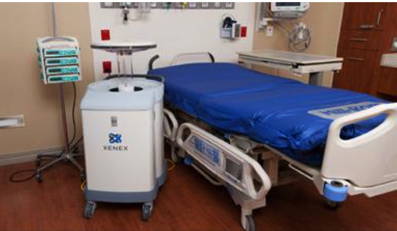 Cleanzine: your weekly cleaning and hygiene industry newsletter 18th April 2024 Issue no. 1110
Cleanzine: your weekly cleaning and hygiene industry newsletter 18th April 2024 Issue no. 1110
Your industry news - first
The original and best - for over 20 years!
We strongly recommend viewing Cleanzine full size in your web browser. Click our masthead above to visit our website version.
Xenex 'robot' halting spread of infection in more than 100 hospitals
 As major news outlets including The Wall Street Journal, USA Today and CBS News have recently reported, US hospitals are engaged in a ferocious battle against the deadly pathogens and multi drug-resistant organisms which cause healthcare associated infections.
As major news outlets including The Wall Street Journal, USA Today and CBS News have recently reported, US hospitals are engaged in a ferocious battle against the deadly pathogens and multi drug-resistant organisms which cause healthcare associated infections.
Hospital cleanliness plays a role in the spread of HAIs, which are caused by microorganisms such as Clostridium difficile, MRSA, Carbapenem-Resistant Enterobacteriaceae (CRE) and Acinetobacter baumannii. Hospital cleaning teams are not able to disinfect all the surfaces in patient rooms in the allotted time, with research showing that more than half of the surfaces remain untouched. Some superbugs such as C. diff are showing resistance to disinfectants, making them even more difficult to eliminate. Others, such as CRE, have developed a resistance to antibiotics, making them nearly impossible to treat.
HAIs are responsible for approximately 100,000 deaths in the US each year - and many patients aren't aware that they may contract an infection as a result of their hospital stay. Innovative hospitals throughout the US including MD Anderson Cancer Center, WellStar Health System, St. Joseph's Hospital Health Center and Cooley Dickinson Hospital are utilising a portable room disinfection system from Xenex Healthcare Services to make their patients safer.
The Xenex 'robot' uses pulse xenon to deliver ultraviolet light throughout patient rooms, operating rooms, equipment rooms, emergency rooms, intensive care units and public areas to destroy viruses, bacteria and bacterial spores in just 5 - 10 minutes per room. Uniquely designed for ease of use and portability, the device can be operated by a hospital's environmental services staff without disrupting hospital operations or requiring the use of expensive chemicals. It can disinfect more than 30 rooms per day, so hospitals use them continuously to reduce contamination levels throughout their facilities.
"The most important step in infection control begins with a clean environment and that's what Xenex's room disinfection system accomplishes," explains Dr. Mark Stibich, Chief Scientific Officer of Xenex. "In just 5 - 10 minutes per room, our device can eliminate the deadly microorganisms and superbugs that cause infections. We have proven repeatedly that the science of our pulsed xenon light makes it incredibly effective against the most challenging bacteria, viruses and even C. diff spores.
"Every week we hear reports from our customers that they are experiencing fewer patient infections as a result of using our device, which is extremely gratifying. We are in a war against deadly superbugs - and Xenex is a proven weapon in this battle."
Xenex systems have proven to be effective against a variety of the most dangerous superbugs and studies reportedly show the system is consistently 20 times more effective than standard chemical cleaning practices. A recent study performed at MD Anderson Cancer Center demonstrated that the Xenex system was more effective than bleach in reducing C. diff in patient rooms.
"The Xenex robots have enabled Cooley Dickinson Hospital to not only lower our infection rates, they have been responsible for saving lives," says Dr. Joanne Levin, medical director of the Cooley Dickinson Hospital Infection Prevention Program. "In 2012, we were able to reduce C. diff infections by 53%, which is huge."
And while Xenex is focused on eliminating deadly pathogens which are resistant to traditional cleaning chemicals and antibiotics, some customers are crediting their Xenex system for a reduction in the spread of flu and Norovirus in their facilities. A customer recently used the system to halt a Norovirus outbreak, which was brought into the hospital by a visitor. According to the hospital, several patients and staff members on the floor visited by the infected person quickly developed symptoms. The hospital used the Xenex system to disinfect the rooms, computers and medical equipment where the outbreak occurred.
Morris Miller, CEO of Xenex, says: "With our proven ability to stop Norovirus in its tracks, we are excited by the possibility to stop the spread of these viruses that adversely affect hospitals, cruise ships and hotels. By halting the spread of the virus we are helping facilities prevent these episodes, which is a big step forward in infection control."
Xenex devices are made in the US and are friendlier to the environment than cleaning chemicals or UV devices using toxic mercury. Xenex says it is the only company to offer a xenon-based room disinfection product that is patented, tested, and proven to deliver a germicidal dose of UV-C light capable of killing C. diff in five minutes or less.
7th March 2013







